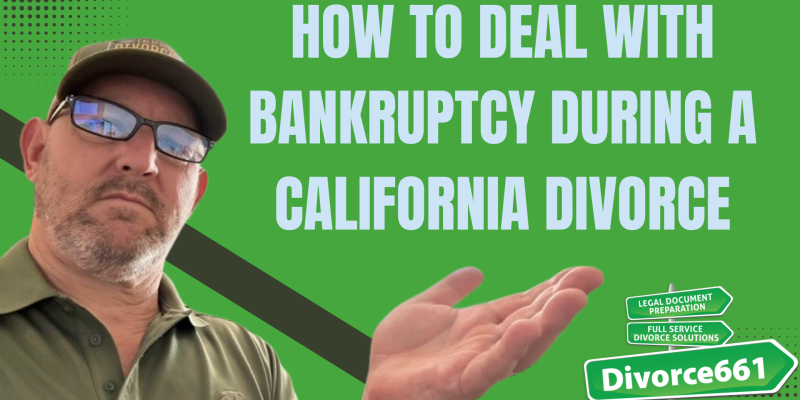How to Deal with Bankruptcy During a California Divorce
I’m Tim Blankenship of Divorce661. If you’re facing divorce while someone in the marriage files bankruptcy, you’re not alone — and this overlap can create real complications. In this article I’ll walk you through what happens when bankruptcy and divorce collide in California, explain the automatic stay and its consequences, share a real client example where Chapter 7 was filed mid-divorce, and give practical steps to keep your case moving forward.
Why this matters: divorce and bankruptcy often intersect
In California, divorce and bankruptcy frequently overlap. When that happens, the two legal systems can pull in different directions. Without careful coordination, you can face delays, unexpected outcomes, or even court-sanctioned mistakes that cost time and money.
What happens when bankruptcy is filed during a divorce?
When someone files for bankruptcy, an automatic stay immediately goes into effect. The automatic stay is a federal protection designed to pause most creditor actions against the debtor. But in the context of divorce, that pause has specific consequences:
- Property division and debt allocation can be put on hold.
- Creditors cannot pursue collections against the debtor while the stay is in effect.
- Certain family-law matters may continue, but financial aspects tied to the bankrupt spouse’s estate often require the bankruptcy court’s approval.
Why the automatic stay complicates divorce
Division of assets and debts is the heart of many divorces. If one spouse files bankruptcy mid-divorce, the bankruptcy estate may include community property and debts. That creates friction between the family court’s authority to divide marital property and the bankruptcy court’s control over the debtor’s estate. Without coordination, you risk having proposed property or debt divisions blocked or unwound.
Real client example: Chapter 7 filed mid-divorce
Here’s a real-world scenario we’ve handled: a couple was in the middle of their divorce when one spouse filed Chapter 7 bankruptcy. The filing triggered an automatic stay that threatened to pause the divorce’s financial resolution.
How we handled it:
- We immediately communicated with the bankruptcy attorney to clarify which assets and debts were part of the bankruptcy estate.
- We reviewed the proposed division to ensure compliance with both the family court and the bankruptcy code.
- When necessary, we coordinated petitions and filings so the bankruptcy court either allowed the divorce division to proceed or gave clear direction on how debts would be treated.
Result: The parties avoided costly errors and finalized their divorce without having the bankruptcy derail the settlement. Coordinated legal strategy made the difference.
Why coordination between divorce and bankruptcy attorneys is critical
When two courts may have jurisdiction over related matters, the attorneys representing each side must be aligned. Coordination helps you:
- Identify which debts are dischargeable in bankruptcy versus which may remain as obligations assigned by the family court.
- Avoid attempting to divide assets that are part of the bankruptcy estate without the bankruptcy court’s blessing.
- Prevent inadvertent violations of the automatic stay.
- Request relief from the stay when appropriate so necessary family-law actions can continue.
Simple coordination steps
- Notify both attorneys as soon as bankruptcy is filed.
- Share copies of pleadings so each attorney understands the other court’s timeline and orders.
- Discuss whether a motion for relief from the automatic stay is necessary to proceed with property division.
- Confirm which debts are community obligations and which belong solely to one spouse.
Practical tips if you’re in this situation
- Don’t ignore the bankruptcy: Even if your focus is divorce, a bankruptcy filing affects the process.
- Get experienced counsel: Work with a divorce attorney familiar with bankruptcy overlaps and a qualified bankruptcy attorney.
- Keep records: Preserve documentation about assets, debts, and settlement proposals to present clearly to both courts.
- Consider timing: Sometimes delaying certain filings or moving forward with other uncontested issues can minimize disruption.
How Divorce661 can help
At Divorce661 we specialize in helping couples navigate complicated overlaps like divorce and bankruptcy. Our services include:
- Flat-fee divorce services across California.
- Coordination with bankruptcy attorneys to ensure compliance with both courts.
- Trusted professional referrals when cases require specialized bankruptcy counsel.
- Court-approved paperwork designed to avoid delays and complications.
In the case described above, timely coordination with a bankruptcy attorney allowed us to proceed without costly missteps. That’s the practical advantage of having experienced professionals on your side.
Conclusion — protect your finances and move forward with confidence
Bankruptcy and divorce together create a complex legal landscape. The automatic stay can pause important financial decisions in your divorce, but with the right strategy and coordinated legal counsel you can protect your interests and keep your case on track.
“By aligning our legal processes, we avoided potential pitfalls and ensured the divorce moved forward without costly mistakes.”
If you’re dealing with both divorce and bankruptcy, don’t wait. Schedule a free consultation with Divorce661 so we can evaluate your situation and help you take the right next steps. Visit Divorce661.com to get started.

